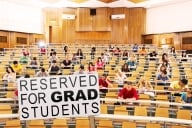You have /5 articles left.
Sign up for a free account or log in.
Middlebury College says it has become carbon neutral, meeting an aggressive goal set last decade and becoming one of just a handful of institutions to reach the sought-after sustainability status.
Its path, however, was not easy or without dispute.
The private liberal arts college in Vermont is today officially announcing it met its target to become carbon neutral by 2016. President Laurie Patton was expected to tell alumni about the milestone at a New York City holiday party Wednesday night. Trustees in 2007 adopted the goal, which does not call for the elimination of all carbon emissions. Instead, carbon neutrality means the campus balances the amount of carbon emissions it releases by offsetting or sequestering equivalent amounts.
Although only a few campuses have reported reaching carbon-neutral status -- among them the College of the Atlantic, Green Mountain College and Colby College -- Middlebury is perhaps the largest in the country to do so. At about 2,500 undergraduate students, Middlebury is not a huge institution, but it still had to sink significant time and resources into changing the way it uses energy. The carbon-neutral status covers Middlebury's main campus, nearby Bread Loaf Mountain Campus and a nearby ski area, but not its California campus.
The college pumped $1.5 million into efficiency upgrades. In 2009 it built a $12 million heating facility burning gas from wood biomass that cut millions of gallons of fuel oil being burned. It also invested in solar-energy projects.
In addition, officials hoped to be able to count on a project to turn cow manure into fuel, but it has yet to materialize. So to cross the carbon-neutral finish line, the college is using carbon credits from preserving thousands of acres Middlebury owns at the Bread Loaf Mountain campus.
That move could provoke some debate on campus, as students have questioned the use of credits in the past. It wouldn’t be the only debate over carbon neutrality. A pipeline project tied into a biomethane gas project has sparked fierce debate, and students have scrutinized everything from the existing biomass plant to student engagement in carbon neutrality.
Leaders say the preserved forest captures carbon and that they’re protecting it from future development. They add that it allows them to avoid purchasing carbon credits from elsewhere.
The resolution trustees passed called for reaching carbon neutrality by changing the way Middlebury operates, said Jack Byrne, its director of sustainability integration. Offsets were intended as a last resort.
“We did our best to avoid having to buy other people’s offsets,” Byrne said. “And I think we’re really pleased that we were able to create our own internal offsets, in effect, through conservation of this land. We can look at this as something we generated by our own actions, by conserving these lands.”
Middlebury announced a deal in 2014 backed by a preservation fund to conserve 2,100 acres of Bread Loaf land in perpetuity. At the time, the preservation wasn’t linked to carbon credits.
An argument can be made that Middlebury didn’t actually change its practices by taking credit for preserving undeveloped Bread Loaf land. It’s an argument that’s already been talked about on campus, said David Allen, an assistant professor of biology who co-chairs Middlebury’s Environmental Council, a student, staff and faculty body.
“I think the students will pick up on it,” he said. “Some of them did mention it, even in the environmental council.”
Students may feel that Middlebury did not exhaust every last feasible option for cutting its carbon footprint, Allen said. The council has debated whether credits generated at Middlebury are better than ones that would be purchased on a carbon credit market.
Still, there are indications that many students may not see the move as gaming the system. Michael Shrader, a junior studying economics and environmental studies who is the director of environmental affairs for Middlebury’s Student Government Association, cautioned against seeing carbon neutrality as a clear-cut end goal. Middlebury appears to be meeting its goal using standard practices, he said.
“Obviously it would be much better if perhaps an institution was able to meet a goal like that without offsets or whatever questionable calculations,” Shrader said. “But that’s sort of unprecedented for an institution like Middlebury. We’re going to keep working. Carbon neutrality is not an end.”
Using land that the institution owns is different than simply gaming carbon credits, argued Nan Jenks-Jay, dean of environmental affairs. It shows a difference in the way the institution thinks about its land and a greater future commitment to environmental stewardship, she said.
Middlebury has restricted its future financial options by pledging to conserve the land. Real estate has value and can provide a boost in tight financial times.
“Colleges and universities tend to think about land as an asset,” Jenks-Jay said. “They tend not to protect it, because it has value and trustees have fiduciary responsibility.”
Middlebury’s experience going carbon neutral also represents a study in timing. When the institution said it would pursue the goal in 2007, many other institutions were making similar pledges. Hundreds of campuses adopted the American College and University Presidents Climate Commitment in June of that year, pledging to reduce greenhouse gas emissions. By the next year, many institutions had already fallen behind in work under that commitment, missing a deadline for baseline reports on emissions.
Many other institutions laid out later timelines for carbon neutrality, setting goals in 2020 or 2050, Jenks-Jay said. Middlebury, with its nine-year timeline, was forced to move more quickly. It was also forced to put in consistent effort.
“I think the Middlebury experience shows something about the ability to sustain the commitment,” Jenks-Jay said. “The piece that might be important is the ability to sustain the enthusiasm.”
Every college pursuing carbon neutrality has followed a different path, said Janna Cohen-Rosenthal, climate programs director for Second Nature, a Boston-based nonprofit organization of which the American College and University Presidents Climate Commitment is a part. The commitment is now called the Climate Leadership Commitment.
The different paths included varying timelines and strategies for tackling carbon emissions. Few institutions set aggressive short-term targets like Middlebury did, Cohen-Rosenthal said. Some set ambitious targets to cut or offset emissions by a certain percentage over the short term but did not commit as strongly to a long-term path for reaching full neutrality.
Middlebury’s size makes it an interesting study in institutionwide change. It faced both challenges and advantages.
“From my perspective, it’s maybe easier for a small school to get some behavioral changes passed,” Cohen-Rosenthal said. “But to address how they buy and use energy can be challenging. They’re not as in control about it, and they don’t have as much of a say in the market.”
It’s also worth noting that Middlebury’s efforts to cut its carbon footprint predate the presidents’ climate commitments and even its own current president’s tenure. The college traced interest in carbon neutrality back to 2001 when it drew up an environmental report recommending a carbon neutrality goal. The next year, Middlebury’s environmental council plotted a carbon reduction initiative that resulted in a recommended reduction of greenhouse gas emissions of 8 percent below 1990 levels by 2012.
Students sought to go further, pushing for a carbon-neutral goal. The president at the time, Ron Liebowitz, listened to them and brought the idea before trustees.
Jon Isham, a professor of economics and environmental studies, taught courses in the early 2000s that helped lay the groundwork for the proposal that’s credited with convincing the board to commit to carbon neutrality by 2016. Isham emphasized that the plan was led by students, while also giving Liebowitz credit for pushing the initiative.
Ultimately, though, students had to show that the idea was feasible and could make financial sense, posting a good internal rate of return.
“I think the truth is, when you crunched the numbers and compared the projected costs associated with fuel oil and wood chips, the IRR looked awfully good,” Isham said. “The board wasn’t going to end up spending without thinking they were making smart financial decisions.”
Isham acknowledged that reaching carbon-neutral status does not make Middlebury perfect. Still, it created a better carbon footprint by burning wood instead of fuel oil, he said. Middlebury argues burning locally sourced wood chips can contribute to carbon-neutral status because forests supplying the wood grow faster than wood is harvested -- absorbing more carbon than is emitted by burning.
The institution has also acknowledged the financial case behind the move. The energy-efficiency upgrades it made save 4.52 million kilowatt-hours per year, which would cost about $636,000 annually. The biomass plant that burns wood chips has been saving about $1 million or $2 million per year and has been operating long enough that it is approaching the break-even point, said Byrne, director of sustainability implementation.
The solar projects Middlebury invested in are also producing revenue, Byrne said. And the Bread Loaf forest preservation will produce enough carbon credits that it will be cash positive.
The campus has more to do even after the carbon-neutrality goal has been reached, according to Byrne. He plans to discuss future goals with faculty, staff and students.
“There are plenty of other challenges,” Byrne said. “We hope to have more of a ripple effect beyond the campus.”








